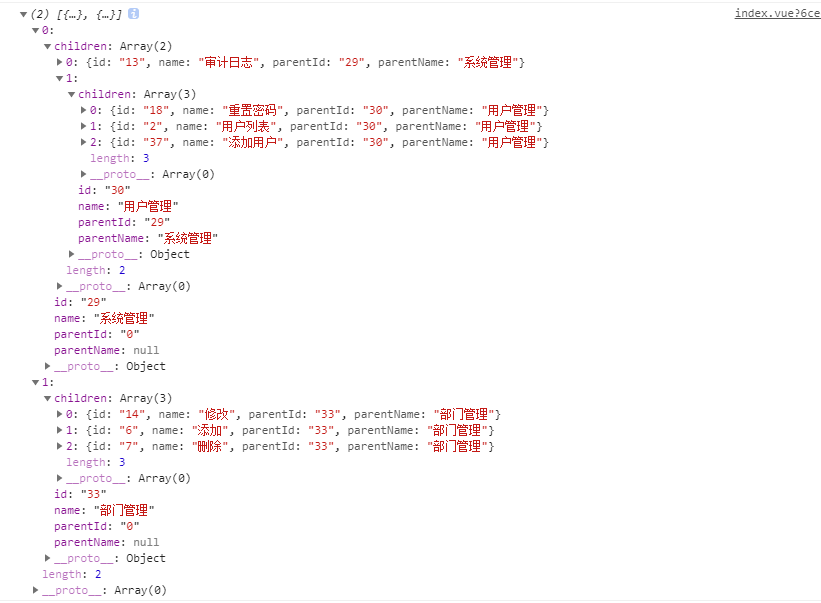目录
- 定义
- 语法
- 实例
- 1. 没有传递初始值init
- 2. 传递初始值的情况下
- 3. 数组去重
- 4. 利用 reduce 对数组中的 Object 对象进行分组及合并
- 5. 利用 reduce 处理菜单后端返回的菜单结构
定义
reduce() 方法对数组中的每个元素执行一个由您提供的reducer函数(升序执行),将其结果汇总为单个返回值。
reduce() 与forEach()、map()、filter()这些方法一样,也会对数组中的每一项进行遍历,但是reduce() 可以将遍历的前一个数组项产生的结果与当前遍历项进行运算。
语法
array.reduce(function(prev, cur, index, array){
...
}, init);
回调函数中的参数:
- prev 必需。表示调用回调时的返回值,或者初始值 init。
- cur 必需。表示当前元素。
- index 可选。表示当前元素的索引。
- array 表示原数组。
- init 可选。初始值,作为第一次调用回调函数的第一个参数。
其中常用参数:prev 和 cur
注意:回调函数第一次执行时,prev和cur的取值有两种情况:如果调用reduce()时提供了初始值init,prev取init值,cur取数组中的第一个值,此时索引从0开始;如果没有提供初始值init,则prev取数组中的第一个值,cur取数组中的第二个值,此时索引从1开始。
实例
1. 没有传递初始值init
const arr = [1, 3, 5, 7]
arr.reduce(function(prev, cur, index, arr){
console.log(prev, cur, index)
return prev + cur
})
每次调用的参数和返回值如下表:
| callback | prev | cur | index | array | return value |
|---|---|---|---|---|---|
| 第1次 | 1 | 3 | 1 | [1, 3, 5, 7] | 4 |
| 第2次 | 4 | 5 | 2 | [1, 3, 5, 7] | 9 |
| 第3次 | 9 | 7 | 3 | [1, 3, 5, 7] | 16 |
因为没有传入初始值,所以索引是从1开始,callback被调用三次,开始时prev的值为数组第一项1,cur的值为3,相加之后返回值4作为下一轮回调的prev值,然后继续下一轮的回调,直至完成后返回。
2. 传递初始值的情况下
const arr = [1, 3, 5, 7]
arr.reduce(function(prev, cur, index, arr){
console.log(prev, cur, index)
return prev + cur
}, 10)
每次调用的参数和返回值如下表:
| callback | prev | cur | index | array | return value |
|---|---|---|---|---|---|
| 第1次 | 10 | 1 | 0 | [1, 3, 5, 7] | 11 |
| 第2次 | 11 | 3 | 1 | [1, 3, 5, 7] | 14 |
| 第3次 | 14 | 5 | 2 | [1, 3, 5, 7] | 19 |
| 第4次 | 19 | 7 | 3 | [1, 3, 5, 7] | 26 |
3. 数组去重
const arr = ['ab', 'v', 'd', 'ab', 'h', 'e', 'dc', 'e', 'e', 'f']
const newArr = arr.reduce(function(prev, cur){
!prev.includes(cur) && prev.push(cur)
return prev
}, [])
console.log(newArr) // ["ab", "v", "d", "h", "e", "dc", "f"]
执行的步骤如下:
- 初始化一个空数组
- 第一次调用时,prev 为初始值即空数组,cur 为数组中的第一项 arr[1],然后在 prev 中查找 cur 是否已经存在,如果不存在就将该项添加到 prev 中,并 prev 返回进入下一次回调
- 第二次回调时,prev 为第一次的返回值,cur 为数组中的第二项 arr[2],然后在 prev 中查找 cur 是否已经存在,如果不存在就将该项添加到 prev 中,并 prev 返回进入下一次回调
- 最后将 prev 这个数组返回
4. 利用 reduce 对数组中的 Object 对象进行分组及合并
//从后台获取的对象数组,根据对象的type进行分组合并成tree树形展示数据
const dataArr = [
{ type: '治理层', name: 'hive_82', reserve: '2', id: 1 },
{ type: '原始数据层', name: 'qwe', reserve: '1', id: 2 },
{ type: '贴源层', name: 'mysql_exchangis', reserve: '3', id: 3 },
{ type: '治理层', name: 'links_188', reserve: '1', id: 4 },
{ type: '贴源层', name: 'mysql_ces', reserve: '2', id: 5 }
]
const treeData = dataArr.reduce((cur, next) => {
const obj = cur.find(curItem => curItem.label === next.type)
if (obj) {
if (obj.children.indexOf(next.id) === -1) { //去重处理
obj.children.push({
...next,
label: next.name
})
}
} else {
const newObj = {
label: next.type,
children: [{
...next,
label: next.name
}]
}
cur.push(newObj)
}
return cur
}, [])
// 合并后的结果:
treeData = [
{
label: '治理层',
children: [
{ type: '治理层', name: 'hive_82', reserve: '2', id: 1, label: 'hive_82' },
{ type: '治理层', name: 'links_188', reserve: '1', id: 4, label: 'links_188' }
]
},
{
label: '原始数据层',
children: [
{ type: '原始数据层', name: 'qwe', reserve: '1', id: 2, label: 'qwe' }
]
},
{
label: '贴源层',
children: [
{ type: '贴源层', name: 'mysql_exchangis', reserve: '3', id: 3, label: 'mysql_exchangis' },
{ type: '治理层', name: 'mysql_ces', reserve: '2', id: 5, label: 'mysql_ces' }
]
}
]
5. 利用 reduce 处理菜单后端返回的菜单结构
需要根据 parentId 将这些数据转换成层级结构。
方法一:
const dataArr = [
{id: '18', name: '重置密码', parentId: '30',parentName: '用户管理'},
{id: '13', name: '审计日志', parentId: '29', parentName: '系统管理'},
{id: '29', name: '系统管理', parentId: '0', parentName: null},
{id: '14', name: '修改', parentId: '33', parentName: '部门管理'},
{id: '2', name: '用户列表', parentId: '30', parentName: '用户管理'},
{id: '30', name: '用户管理', parentId: '29', parentName: '系统管理'},
{id: '33', name: '部门管理', parentId: '0', parentName: null},
{id: '37', name: '添加用户', parentId: '30', parentName: '用户管理'},
{id: '6', name: '添加', parentId: '33', parentName: '部门管理'},
{id: '7',name: '删除', parentId: '33', parentName: '部门管理'}
]
//创建菜单id的映射关系
const idMapping = dataArr.reduce((prev, next, i) => {
prev[next.id] = i
return prev
}, {})
const treeData = []
dataArr.map(el => {
// 一级菜单
if (el.parentId === '0') {
treeData.push(el)
return
}
// 通过映射找到父元素
const parentEl = dataArr[idMapping[el.parentId]]
// 把当前元素添加到父元素的`children`数组中
parentEl.children = [...(parentEl.children || []), el]
})
console.log(treeData)
方法二:
//根据parentId创建映射关系
const result = dataArr.reduce((prev, next) => {
prev[next.parentId] ? prev[next.parentId].push(next) : prev[next.parentId] = [next];
return prev;
}, {});
Object.keys(result).map(key => {
result[key].map((item, i) => {
result[item.id] ? item.children = result[item.id] : ''
});
})
this.treeData = result[0]
console.log(treeData)
还可以通过递归的方法来实现,具体就不赘述了
最后生成的数据结构如下图所示:

以上就是JS使用reduce()方法处理树形结构数据的详细内容,更多关于JS的资料请关注NICE源码其它相关文章!










